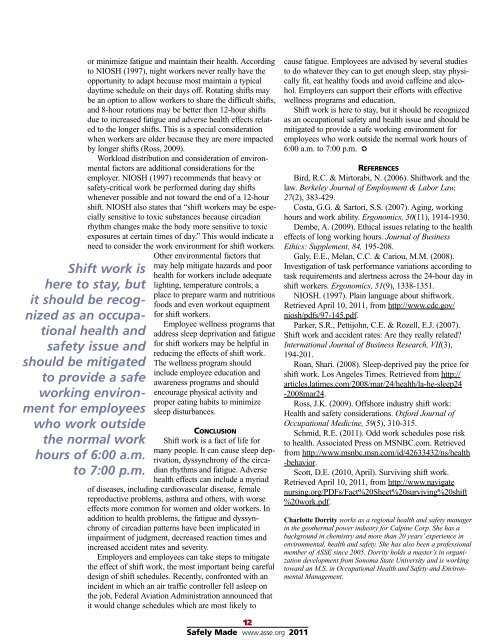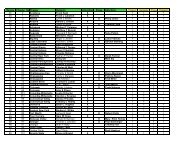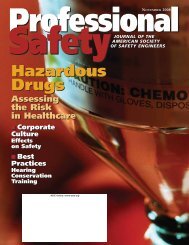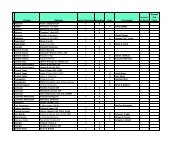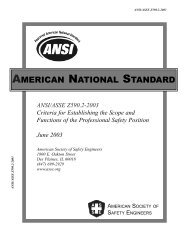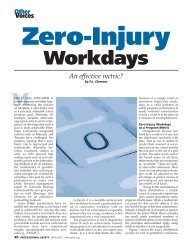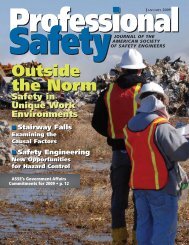Safety & Health Effects of Shift Work - ASSE Members
Safety & Health Effects of Shift Work - ASSE Members
Safety & Health Effects of Shift Work - ASSE Members
Create successful ePaper yourself
Turn your PDF publications into a flip-book with our unique Google optimized e-Paper software.
<strong>Shift</strong> work is<br />
here to stay, but<br />
it should be recognized<br />
as an occupational<br />
health and<br />
safety issue and<br />
should be mitigated<br />
to provide a safe<br />
working environment<br />
for employees<br />
who work outside<br />
the normal work<br />
hours <strong>of</strong> 6:00 a.m.<br />
to 7:00 p.m.<br />
or minimize fatigue and maintain their health. According<br />
to NIOSH (1997), night workers never really have the<br />
opportunity to adapt because most maintain a typical<br />
daytime schedule on their days <strong>of</strong>f. Rotating shifts may<br />
be an option to allow workers to share the difficult shifts,<br />
and 8-hour rotations may be better then 12-hour shifts<br />
due to increased fatigue and adverse health effects related<br />
to the longer shifts. This is a special consideration<br />
when workers are older because they are more impacted<br />
by longer shifts (Ross, 2009).<br />
<strong>Work</strong>load distribution and consideration <strong>of</strong> environmental<br />
factors are additional considerations for the<br />
employer. NIOSH (1997) recommends that heavy or<br />
safety-critical work be performed during day shifts<br />
whenever possible and not toward the end <strong>of</strong> a 12-hour<br />
shift. NIOSH also states that “shift workers may be especially<br />
sensitive to toxic substances because circadian<br />
rhythm changes make the body more sensitive to toxic<br />
exposures at certain times <strong>of</strong> day.” This would indicate a<br />
need to consider the work environment for shift workers.<br />
Other environmental factors that<br />
may help mitigate hazards and poor<br />
health for workers include adequate<br />
lighting, temperature controls, a<br />
place to prepare warm and nutritious<br />
foods and even workout equipment<br />
for shift workers.<br />
Employee wellness programs that<br />
address sleep deprivation and fatigue<br />
for shift workers may be helpful in<br />
reducing the effects <strong>of</strong> shift work.<br />
The wellness program should<br />
include employee education and<br />
awareness programs and should<br />
encourage physical activity and<br />
proper eating habits to minimize<br />
sleep disturbances.<br />
CONCLUSION<br />
<strong>Shift</strong> work is a fact <strong>of</strong> life for<br />
many people. It can cause sleep deprivation,<br />
dyssynchrony <strong>of</strong> the circadian<br />
rhythms and fatigue. Adverse<br />
health effects can include a myriad<br />
<strong>of</strong> diseases, including cardiovascular disease, female<br />
reproductive problems, asthma and others, with worse<br />
effects more common for women and older workers. In<br />
addition to health problems, the fatigue and dyssynchrony<br />
<strong>of</strong> circadian patterns have been implicated in<br />
impairment <strong>of</strong> judgment, decreased reaction times and<br />
increased accident rates and severity.<br />
Employers and employees can take steps to mitigate<br />
the effect <strong>of</strong> shift work, the most important being careful<br />
design <strong>of</strong> shift schedules. Recently, confronted with an<br />
incident in which an air traffic controller fell asleep on<br />
the job, Federal Aviation Administration announced that<br />
it would change schedules which are most likely to<br />
cause fatigue. Employees are advised by several studies<br />
to do whatever they can to get enough sleep, stay physically<br />
fit, eat healthy foods and avoid caffeine and alcohol.<br />
Employers can support their efforts with effective<br />
wellness programs and education.<br />
<strong>Shift</strong> work is here to stay, but it should be recognized<br />
as an occupational safety and health issue and should be<br />
mitigated to provide a safe working environment for<br />
employees who work outside the normal work hours <strong>of</strong><br />
6:00 a.m. to 7:00 p.m. <br />
REFERENCES<br />
Bird, R.C. & Mirtorabi, N. (2006). <strong>Shift</strong>work and the<br />
law. Berkeley Journal <strong>of</strong> Employment & Labor Law,<br />
27(2), 383-429.<br />
Costa, G.G. & Sartori, S.S. (2007). Aging, working<br />
hours and work ability. Ergonomics, 50(11), 1914-1930.<br />
Dembe, A. (2009). Ethical issues relating to the health<br />
effects <strong>of</strong> long working hours. Journal <strong>of</strong> Business<br />
Ethics: Supplement, 84, 195-208.<br />
Galy, E.E., Melan, C.C. & Cariou, M.M. (2008).<br />
Investigation <strong>of</strong> task performance variations according to<br />
task requirements and alertness across the 24-hour day in<br />
shift workers. Ergonomics, 51(9), 1338-1351.<br />
NIOSH. (1997). Plain language about shiftwork.<br />
Retrieved April 10, 2011, from http://www.cdc.gov/<br />
niosh/pdfs/97-145.pdf.<br />
Parker, S.R., Pettijohn, C.E. & Rozell, E.J. (2007).<br />
<strong>Shift</strong> work and accident rates: Are they really related<br />
International Journal <strong>of</strong> Business Research, VII(3),<br />
194-201.<br />
Roan, Shari. (2008). Sleep-deprived pay the price for<br />
shift work. Los Angeles Times. Retrieved from http://<br />
articles.latimes.com/2008/mar/24/health/la-he-sleep24<br />
-2008mar24.<br />
Ross, J.K. (2009). Offshore industry shift work:<br />
<strong>Health</strong> and safety considerations. Oxford Journal <strong>of</strong><br />
Occupational Medicine, 59(5), 310-315.<br />
Schmid, R.E. (2011). Odd work schedules pose risk<br />
to health. Associated Press on MSNBC.com. Retrieved<br />
from http://www.msnbc.msn.com/id/42633432/ns/health<br />
-behavior.<br />
Scott, D.E. (2010, April). Surviving shift work.<br />
Retrieved April 10, 2011, from http://www.navigate<br />
nursing.org/PDFs/Fact%20Sheet%20surviving%20shift<br />
%20work.pdf.<br />
Charlotte Dorrity works as a regional health and safety manager<br />
in the geothermal power industry for Calpine Corp. She has a<br />
background in chemistry and more than 20 years’ experience in<br />
environmental, health and safety. She has also been a pr<strong>of</strong>essional<br />
member <strong>of</strong> <strong>ASSE</strong> since 2005. Dorrity holds a master’s in organization<br />
development from Sonoma State University and is working<br />
toward an M.S. in Occupational <strong>Health</strong> and <strong>Safety</strong> and Environmental<br />
Management.<br />
12<br />
Safely Made www.asse.org 2011


